MREs can last for 3 to 5 years when stored at 80°F. When properly refrigerated, MRES can last for up to 15 years. MRE packages are thermostabilized to keep the food for an extended time. However, the lifespan of your MREs can be affected by the storage temperatures. Higher storage temperatures will shorten the lifespan, while lower storage temperatures may lengthen the lifespan.
MREs are a lifesaver especially when out camping, on holiday, hunting, or in emergencies where you do not have access to food. Though the food is ready to eat, the packages do not have an expiry date, which has raised so many questions on how long MREs last?
And if you have been wondering whether MREs are your thing, then you are in the right place. For this piece, we will take you through in-depth research on MREs. But before getting into those exciting parts, get to know them better.
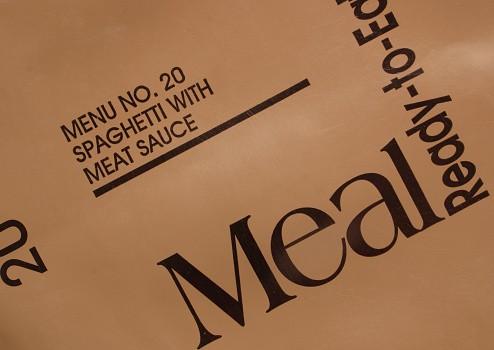
What Are MREs?
MREs (Meals Ready to Eat) are self-packed foods ready to eat. The food is commonly bought by the US Department of Defense for use by its service members when out for training or on a mission. The fact that the US military uses the food (MREs) does not mean that they are not allowed to be sold. Nowadays, MRE manufacturers are producing quality MREs for sale online other than military MREs, so you should not be scared of getting a pack. There are fewer chances to sell Military MREs or military field rations.
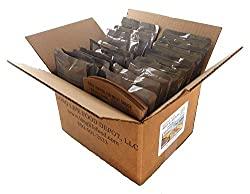
Also Read:Best MRE Meals for Survival and Emergency Situations
What Are MREs Made Of?
MREs have the following foods with sufficient nutritional value:
- Entrée – the main dish which comprises of beef stew and spaghetti
- Accompaniments/side dish- rice, fruit, corned beef hash, mashed potatoes
- Dessert- pound cakes or cookies
- Beverages- Tea, instant coffee, cocoa, chocolate, dairy shakes, and Gatorade-like mixes
- Bread or cracker
- Candy- Tootsie Rolls, Skittles, M&Ms
- Spread- cheese spreads, peanut butter, or jelly
- Seasoning or hot sauce in some packages
- Ration heater(frameless)- for heating the entrée
- Accessories – sugar, salt, toilet paper, chewing gum, spoon, matches, and creamer, among others
Benefits To Eat (Meals Ready To Eat) MREs
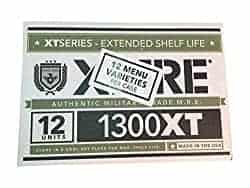
Saves time: MREs do not require cooking. This saves your time and enables you to pay attention to more critical issues.
Nutritionally balanced: Before MRE packaging and release into the market, it undergoes stringent inspection to make sure its nutritional content is well balanced. This ensures you supply your body with healthy nutrients and keep your calories intake in check.
Longer shelf life: MREs are pressure packaged to ensure the food lasts you for long. And with good storage conditions, the food can last you for years. You can take help from the estimated expiration date and date of MRE stored in this regard.
Are MREs Healthy?
MREs are loaded with nutrients and energy to keep your body fueled. However, if you are new to MREs, your body may react differently to the food. This may include a change in urine, stool, energy, appetite, and digestion.
Note that this does not only apply to MREs alone, it is how our bodies respond to weird or foreign food. So that shouldn’t be something to worry about as your body will get used to it after some time. But there is no such case of food poisoning provided you follow the MRE inspection expiration date.
How Many MREs Are Recommended Daily?
Every MRE package is rich in 1250 calories which comprise 51% carbohydrates, 13% proteins, 36% fat, and 1/3 of daily Military recommended minerals and vitamins. So a full day would comprise of 3 MREs. However, if you are looking forward to losing weight, you can consider buy MREs from a brand that is specially designed for weight loss.
Can You Eat MREs Daily?
MREs are specifically designed to be used as survival food. Though you can take them daily, it is recommended to be used for a maximum of 21 days. The reason why it is not advised to go past the limit is simply that MREs have low fiber content. Consuming food low in fiber for a long can trigger severe constipation. Also, be sure to check the MRE shelf-life chart as the shelf life depends on multiple factors.
What Happens If You Eat Too Many MREs?
Too much of everything has its implications, and MREs are not an exception. Usually, MREs are advocated during strenuous activities where more calories are burned. And since most people do not engage in high physical activity, the digestive system tends to respond to the high nutrients.
Overeating MREs can have severe implications on the body, with the stomach being the most vulnerable. People who consume high quantities may suffer from excessive bloating, high fatigue levels, and severe diarrhea. This is because MREs have high nutritional content and staggering levels of sugar.
However, consuming MREs is healthy if taken in moderation. You should trend carefully when extending the recommended limits of the entire MRE package.
Tips For Eating MREs For Long Without Constipation
In some scenarios, you may find yourself in a situation where you do not have access to food or water, which forces you to extend the recommended time. To avoid any effects that come along with long-term consumption of MREs, you should consider the following.
1. Take Advantage Of Veggies
Taking low-calorie vegetables after taking your meal can help prevent any possible implications caused by prolonged MRE intake. The vegetables will help water down the high protein content.
2. Keep The Quantity In Check.
Though the MRE packages are designed to be one serving, you can reduce the quantity by splitting it up. This means you won’t strain your system to digest high-calorie meals reducing the chances of developing complications.
3. Use Vitamins
Adding vitamins to your diet will help supply your body with essential nutrients which may be missing from the MRE. In case you do not have multi-vitamins, you can use fiber pills.
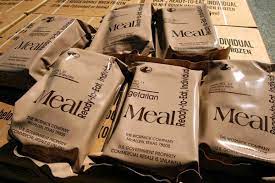
Tips To Store MREs Properly
Proper storage of food is critical, and MREs are not an exception. Poor storage will not only reduce shelf life (MREs) but also impact its nutritional content. Worse still, bacteria may find their way into your food, posing serious health complications.
Knowing how to store your food properly is a great way to keep the taste, nutritional content, and all these bacteria at bay while extending your food’s lifespan. And here are some of the tips you can take advantage of if you are looking forward to expanding your MRE lifespan.
1. Keep The Temperatures In Check
Without refrigeration, MREs can last you for a long. So if you do not have a freezer, keeping the temperatures in check can help prolong your MRE shelf life. You can use the temperature indicator to keep a check. Also, take average shelf life and manufacturing date in acccount.
2. Get A Quality Freezer
MREs storage temperatures affect its shelf life. Freezing your food package will help extend the average MRE lifespan for future use. When properly refrigerated, MRE can last for up to 15 years. When frozen, the package requires careful handling as it is prone to punctures.
Storing it in a freezer will not affect the food quality. However, the package is normally designed to withstand 1000 flexes. Repeated freezing can cause the package to stretch, causing the package laminate layer to break. This can increase the chances of contamination, which can alter your food’s taste, color, or quality.
To avoid that, always ensure that your MRE package is well covered or protected when re-freezing it again. Also, prevent extreme temperatures and extreme weather conditions.
3. Use Freezer-Safe Bags
In case you do not finish your package and wish to refrigerate it again, consider using freezer bags instead of storing it with the opened package. Exposed packages may alter the color or taste of your food, and bacteria may find their way.
How To Know If Your MREs Are Expired?
Since MREs do not have expiry dates stamped on the package, it can be hard for you to know when to bin it. And bearing in mind that the food was not exposed to high temperatures before, you can use the manufactory date to calculate its lifespan.
Normally, an MRE manufacturer date is stamped in codes. But in most cases, the packages will have two different codes. One of the codes represents the manufacture date, while the second one is for the inspection date.
In most cases, the manufacture date comprises of a four-digit code, with some brands having a letter. And if you have never used MREs before, it can be a challenge to interpret the code. The code usually consists of two parts, that is, the first digit and the last three numbers.
The first digit presents the last number of the manufacturing year, while the last three digits stand for the year’s day. For instance, if your package code reads 5365, it means that the 2 stands for the last digit of the manufacturing years, which is 2015, while 365 represents a whole year in the month of December 31.
To calculate the expiry date of your MRE, you need to add up to five years to the manufacturing year. In case you are a regular user of MREs, you need to calculate your package expiry dates and determine the order in which you should be consuming them.
Some brands have indicators or TTI, which help determine the freshness of your meal. The indicator is designed to change based on temperature changes which help you get an accurate readout. The TTI comprises of two parts; the inner and outer circle. The center circle should have a lighter color than the outer one to determine whether your package is safe to eat. Anything different from this means that the package is already expired.
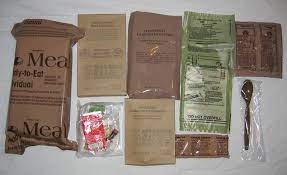
FAQs
1. How Long Does an MRE Last?
An MRE will generally last between three to five years. However, it must be stated that these are just estimations that have been determined under ideal conditions. In a real-life situation with a constantly fluctuating heat and humidity level where the MRE is stored, they can not be guaranteed to last any longer than two years. Also, cool storage temperature also matters.
2. Will MREs Expire?
MRE expiration is not as simple an answer as it would seem. While the “best by” date written on the box may expire, this does not necessarily entail that they are unsafe to eat. It all depends on how old they are when you open them up and consume them, which varies from case to case.
The shelf life of an MRE is not simply a one-time guaranteed period for when it was produced. It actually is constantly “renewed” each time the package is opened. So if you are planning to keep your MREs for more than two years, then they must be stored in conditions that are consistently 60 degrees Fahrenheit or lower without any major fluctuations. Otherwise, their shelf lives will slowly decrease as you use them and eventually expire.
3. How Long Can You Store an MRE Before It Expires?
Food that has been packaged according to U.S. Military standards can remain safe and edible past its expiration date as long as it has been stored properly and remains unopened. However, you should probably still eat the MRE before it has gone bad because its shelf-life is drastically shortened once opened. It should also be said that the peak flavor of an MRE generally occurs prior to three years.
Although this does not mean that they are no longer safe to eat after this point, it does mean that your taste buds will start noticing a difference in quality as time goes on. Once opened, an MRE’s shelf life is about 18 months, but again, this varies from case to case depending on how long the package was sitting around unopened and how humid or hot its storage place was during those first few years.
Conclusion
Whether planning for camping, hunting, or a holiday, taking advantage of MREs will keep your body nourished. The packages are sealed to make sure your food stays fresh for longer and are an excellent choice during times of emergency. So no need to starve your body. Just get enough to last you for the period you will be out on your mission.
Observe the temperatures and use the TTI to determine if the food is safe for consumption. If you plan to take your adventure for more than 21 days, consider following the tips we have provided to avoid any complications.
